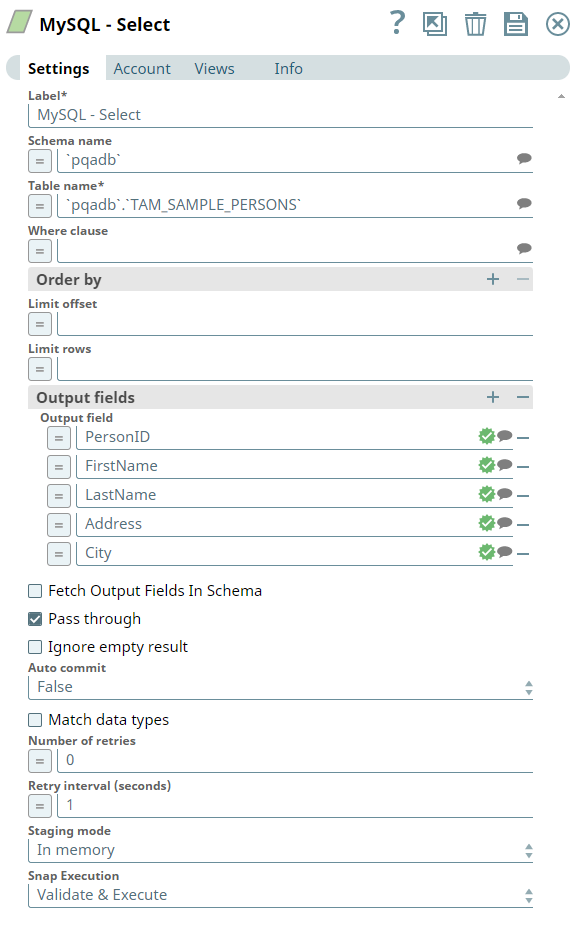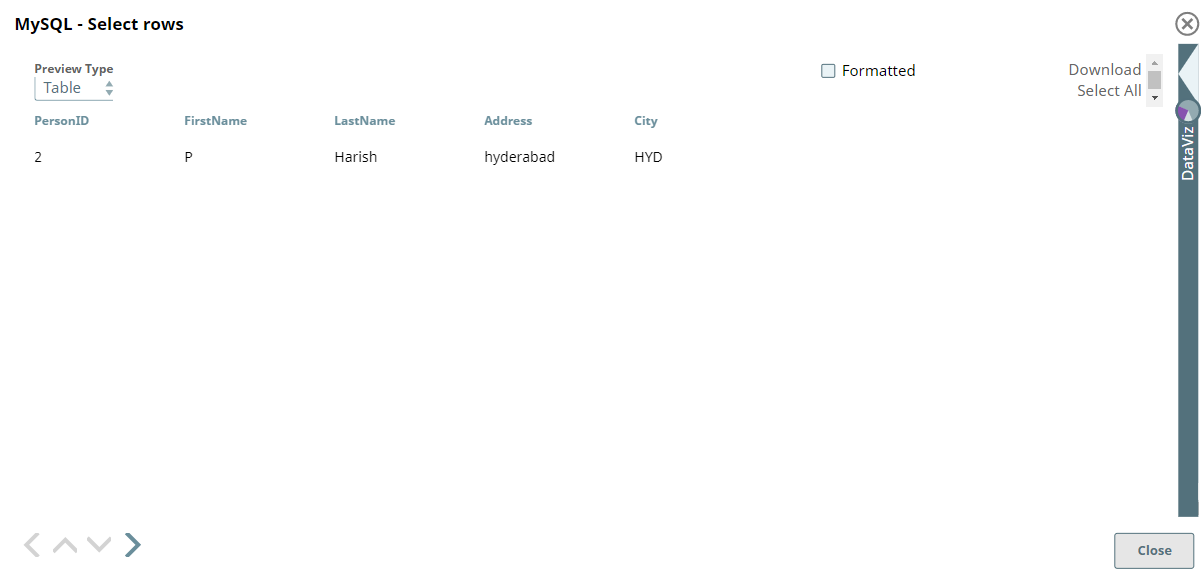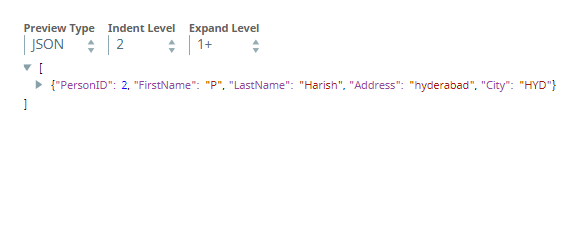On this Page
| Table of Contents | ||||
|---|---|---|---|---|
|
Snap type:
Read
Description:
JSON paths can be used in a query and will have values from an incoming document substituted into the query. However, documents missing values for a given JSON path will be written to the Snap's error view. After a query is executed, the query's results are merged into the incoming document overwriting any existing keys' values. The original document is output if there are no results from the query.
Queries produced by the Snap have an equivalent format:
| Code Block |
|---|
SELECT * FROM [table] WHERE [where clause] ORDER BY [ordering] LIMIT [limit] OFFSET [offset] |
If more powerful functionality is desired, then the Execute Snap should be used.
Hints
Retrieval of 0000-00-00 date time or timestamp values.
You need to set the following on the MySQL account in case you need to deal with 0000-00-00 defined datetime or timestamp values:
Url property name Url property value
zeroDateTimeBehavior convertToNull
This will return all 0000-00-00 defined values as null values. The JDBC driver does not support returning 0000-00-00 as timestamp or datetime values.
[None]
- Works in Ultra Task Pipelines.
Multiexcerpt include macro name MySQLKI page MySQL Snap Pack
This Snap uses account references created on the Accounts page of SnapLogic Manager to handle access to this endpoint. See MySQL Account for information on setting up this type of account.
| Input | This Snap has at most one document input view. If the input view is defined, then the where clause can substitute incoming values for a given expression (in such as to use it as a lookup). |
|---|---|
| Output | A second view can be added to show the metadata for the table as a Document. The metadata document can then be fed into the second input view of MySQL Server - Insert or Bulk Load Snap so that the table is created in MySQL with a similar schema as the source table. |
| Error | This Snap has at most one document error view and produces zero or more documents in the view. |
Settings
Label
Schema name
The database schema name. In case it is not defined, then the suggestion for the Table Name will retrieve all tables names of all schemas. The property is suggestable and will retrieve available database schemas during suggest values.
Example: SYS
Default value: [None]
Required. The name of table to execute insert on.
Example: people
Default value: [None]
The WHERE clause of select statement. This supports document value substitution (such as $person.firstname will be substituted with the value found in the incoming document at the path).
Examples:
On this Page
| Table of Contents | ||||
|---|---|---|---|---|
|
Snap type: | Read | |||||||||||||
|---|---|---|---|---|---|---|---|---|---|---|---|---|---|---|
Description: | This Snap allows you to fetch data from a database by providing a table name and configuring the connection. The Snap produces the records from the database on its output view which can then be processed by a downstream Snap. Queries produced by the Snap have an equivalent format:
If more powerful functionality is desired, then the Execute Snap should be used. HintsRetrieval of 0000-00-00 date time or timestamp values.You need to set the following on the MySQL account in case you need to deal with 0000-00-00 defined datetime or timestamp values: Url property name Url property value This will return all 0000-00-00 defined values as null values. The JDBC driver does not support returning 0000-00-00 as timestamp or datetime values. | |||||||||||||
| Prerequisites: | [None] | |||||||||||||
| Support and limitations: |
| |||||||||||||
| Account: | This Snap uses account references created on the Accounts page of SnapLogic Manager to handle access to this endpoint. See MySQL Account for information on setting up this type of account. | |||||||||||||
| Views: |
| |||||||||||||
Settings | ||||||||||||||
Label
| Required. The name for the Snap. You can modify this to be more specific, especially if you have more than one of the same Snap in your pipeline. | |||||||||||||
Schema name
| The database schema name. In case it is not defined, then the suggestion for the Table Name will retrieve all tables names of all schemas. The property is suggestable and will retrieve available database schemas during suggest values. Example: SYS | |||||||||||||
| Table name | Required. The name of table to execute insert on. Default value: [None] | |||||||||||||
| Where clause | The WHERE clause of select statement. This supports document value substitution (such as $person.firstname will be substituted with the value found in the incoming document at the path). Examples:
| |||||||||||||
| Order by | Enter in the columns in the order in which you want to order by. The default database sort order will be used. Example: name Default value: [None] | |||||||||||||
| Limit offset | Starting row for the query | |||||||||||||
| Limit rows | Starting row for the query | |||||||||||||
| Output fields | Enter or select output field names for SQL SELECT statement. To select all fields, leave it at default. Example: email, address, first, last, etc. Default value: [None] | |||||||||||||
| Fetch Output Fields In Schema |
Default value: Not selected | |||||||||||||
| Pass through | If checked, the input document will be passed through to the output view under the key 'original'. Default value: Selected | |||||||||||||
| Ignore empty result | If selected, no document will be written to the output view when a SELECT operation does not produce any result. If this property is not selected and the Pass through property is selected, the input document will be passed through to the output view. Default value: Not selected | |||||||||||||
| Auto commit | Select one of the options for this property to override the state of the Auto commit property on the account. The Auto commit at the Snap-level has three values: True, False, and Use account setting. The expected functionality for these modes are:
Default value: False | |||||||||||||
| Number of retries | Specifies the maximum number of attempts to be made to receive a response. The request is terminated if the attempts do not result in a response.
Example: 3 Default value: 0 | |||||||||||||
| Retry interval (seconds) | Specifies the time interval between two successive retry requests. A retry happens only when the previous attempt resulted in an exception. Example: 10 Default value: 1 | |||||||||||||
| Match data types | Conditional. This property applies only when the Output fields property is provided with any field value(s). If this property is selected, the Snap tries to match the output data types same as when the Output fields property is empty (SELECT * FROM ...). The output preview would be in the same format as the one when SELECT * FROM is implied and all the contents of the table are displayed. Default value: Not selected | |||||||||||||
| Staging mode | Required when the value in the Number of retries field is greater than 0. Specify the location from the following options to store input documents between retries:
| |||||||||||||
|
| |||||||||||||
| Note |
|---|
For the 'Suggest' in the Order by columns and the Output fields properties, the value of the Table name property should be an actual table name instead of an expression. If it is an expression, it will display an error message "Could not evaluate accessor: ..." when the 'Suggest' button is clicked. This is because, at the time the "Suggest" button is clicked, the input document is not available for the Snap to evaluate the expression in the Table name property. The input document is available to the Snap only during the preview or execution time. |
Example
In this pipeline, the MySQL Select Snap, retrieves the data from the database, formats to CSV using the CSV Formatter Snap and writes to a file using the File Writer Snap.
The MySQL Select Snap retrieves the records from pqadb.TAM_SAMPLE_PERSONS where the output fields are PersonID, FirstName, LastName, Address, City.
The successful validation of the pipeline displays the below output preview:
Upon execution, the File Writer Snap writes the output to a file as shown below:
Downloads
| Multiexcerpt include macro | ||||
|---|---|---|---|---|
|
| Attachments | ||||
|---|---|---|---|---|
|
| Insert excerpt | ||||||
|---|---|---|---|---|---|---|
|



